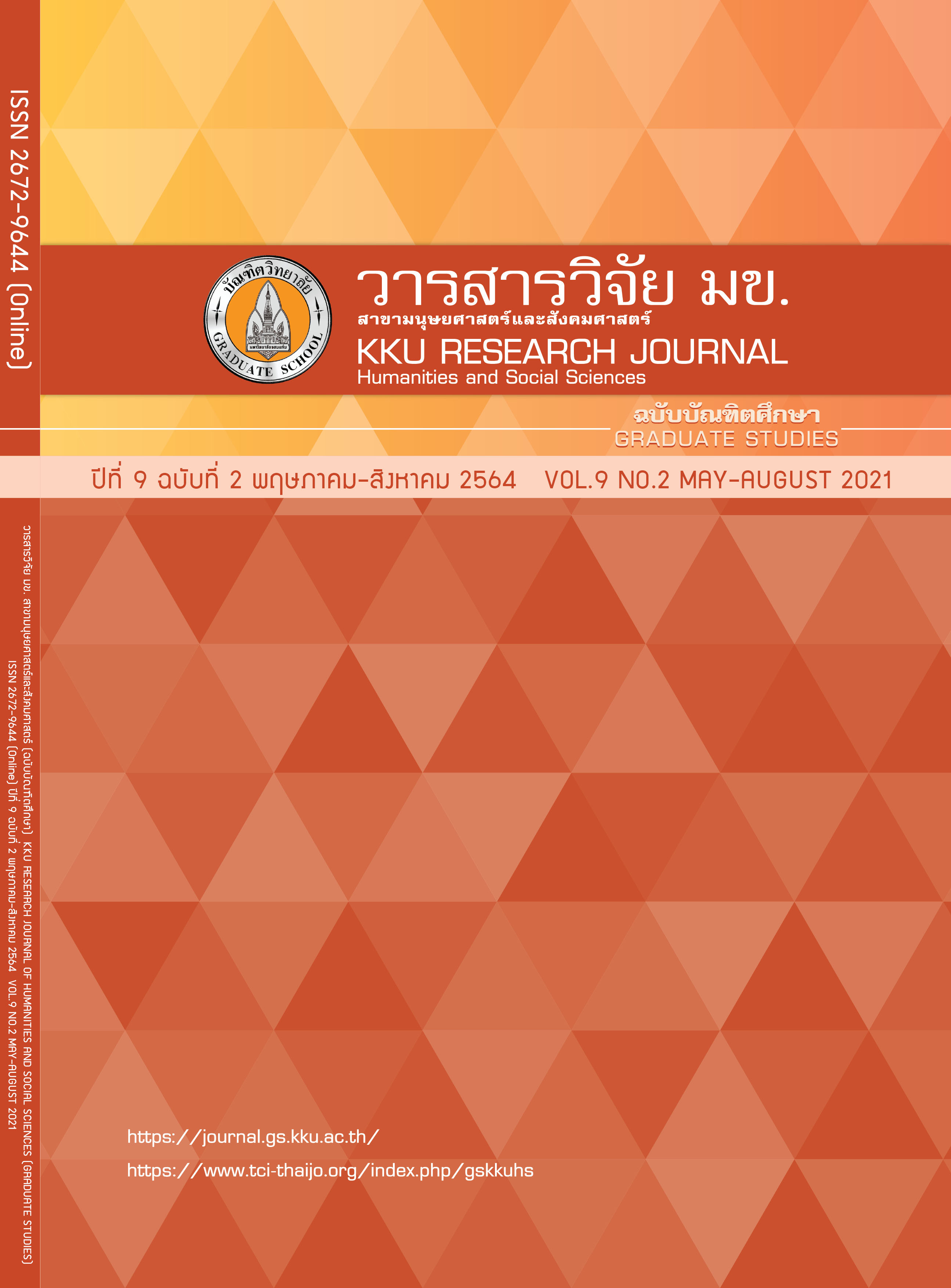A Discourse Analysis of Speech Structure from TED Talks Corpus
คำสำคัญ:
public speaking, TED Talks, discourse analysisบทคัดย่อ
With an intention to reveal how successful public speakers construct their speeches, this study aimed to investigate structure of speeches delivered in TED Talks, one of the influential public speaking platforms these days. The study compiled a corpus of twenty-five most viewed TED speeches in 2019, and all of them were transcribed. Biber et al.’s discourse analytical approach (2007) was adopted for analytical procedures, and Chang and Huang’s conceptual framework (2015) was adapted for rhetorical moves and steps analysis. The study found nine rhetorical moves with the respective steps constructing the TED speeches. Further analysis into different sections of the speeches revealed that the dominants moves were Topic Introduction moves for the introduction section, Topic Development moves for the body section, and Acknowledgement moves for the conclusion section. Focusing on the body section, this study found three possible Topic Development move types, namely Topic Development in Topical Order, Topic Development in Narrative Order and Topic Development in Problem-Solution Order respectively. The knowledge on structure of TED speeches is contributing to public speaking spheres and provides both research and pedagogical implications.
เอกสารอ้างอิง
Mehrabian A Verfasser. Silent messages. Belmont, Calif.: Wadsworth; 1971.
Lucas SE. The Art of Public Speaking. 12th ed. United States of America: McGraw-Hill Education; 2015.
Beebe SA, Beebe SJ. Public Speaking Handbook. 5th ed. Pearson; 2014.
German KM. Principle of Public Speaking. 19th ed. New York: Routledge; 2017.
Gregory H. Public Speaking for College & Career. 11th ed. New York: McGraw-Hill; 2016.
Turner K, Osborn M, Osborn S, Osborn R. Public Speaking. 8th ed. Pearson Education; 2018.
Verderber RF, Verderber KS. The challenge of effective speaking. Australia: Thomson Wadsworth, c2006.; 2006.
Liu H. Genre analysis of English public speeches by Chinese college students based on the corpus study. Tech Bull. 2017 15; 55(14): 193–199.
Wang C. A Comparative Genre Analysis of Schematic Structures in Public Speeches of Native and Nonnative English Speakers. Linguist Lit Stud. 2016 Sep; 4(5): 320–330.
Wei Xu. Exploring language in Chinese college students’ English public speaking contests from a genre perspective and its implications for English Language Teaching. [England]: Durham University; 2017
Maktiar Singh KK, Mohamad Ali A, Chan MY, Tan H. A genre-based investigation of the introduction sections of academic oral presentations. Asian J Univ Educ. 2019; 15(2): 1–31.
Zhan L-L. Understanding Genre in Use. Concentric: Stud Linguist. 2012 Nov 1; 38(2): 211–335.
Gyamera S. Rhetorical Analysis of Anniversary Speeches of Heads of Wesley Girls’ High School and St. Augustine’s College in Cape Coast [Thesis]. University of Cape Coast; 2016. Available from: http://erl.ucc.edu.gh/dspace/handle/ 123456789/3487
Hu G, Liu Y. Three minute thesis presentations as an academic genre: A cross-disciplinary study of genre moves. J Engl Acad Purp. 2018 Sep 1; 35: 16–30.
Chang Y-J, Huang H-T. Exploring TED talks as a pedagogical resource for oral presentations: A corpus-based move analysis. Engl Teach Learn. 2015 01; 39(4): 29–62.
Jiang J. Investigating the rhetorical structure of TED talks: a corpus-based study [Thesis]. Nanyang Technological University; 2017.
Khajornphaiboon P, Vungthong S. Analyzing the introduction of TED Talks: A corpus–based analysis of discourse organization. MANUTSAT Parit J Humanit. 2019 May 9; 41(1).
Ratanakul S. A Study of Problem-Solution Discourse: Examining TED Talks through the Lens of Move Analysis. LEARN J Lang Educ Acquis Res Netw. 2017; 10(2): 25–46.
Swales J 1938-, Verfasser. Genre analysis English in academic and research settings. Cambridge [u.a.]: Cambridge Univ. Pr.; 1990. (The Cambridge applied linguistics series).
Bhatia VK 1942-, Verfasser. Analysing genre language use in professional settings. London [u.a.]: Longman; 1993. (Applied linguistics and language study).
Biber D, Connor U, Upton TA. Discourse on the Move: Using Corpus Analysis to Describe Discourse Structure. Amsterdam: John Benjamins Publishing Co; 2007. (Studies in Corpus Linguistics).
Anthony M, Gladkov K. Rhetorical Appeals in Fundraising. In: Discourse on the Move: Using Corpus Analysis to Describe Discourse Structure. Amsterdam: John Benjamins Publishing Co; 2007. (Studies in Corpus Linguistics).
Upton TA, Thomas A, Cohen MA. An Approach to Corpus-based Discourse Analysis: The Move Analysis as Example. Discourse Stud. 2009; 11(5).
Robinson SK. Do schools kill creativity?. TED2006; 2006.
Treasure J. How to speak so that people want to listen. TEDGlobal 2013; 2013.
Meyer P. How to spot a liar. TEDGlobal 2011; 2011.
Gilbert E. Your elusive creative genius. TED2009; 2009.
Robbins A. The art of misdirection. TEDGlobal 2013; 2013.
Russell C. Looks aren’t everything. Believe me, I’m a model. TEDxMidAtlantic; 2012.
Taylor JB. My stroke of insight. TED2008; 2008.
Pink D. The puzzle of motivation. TEDGlobal 2009; 2009.
Cuddy A. Your body language may shape who you are. TEDGlobal2012; 2012.
Brown B. The power of vulnerability. TEDxHouston; 2010.
Adichie CN. The danger of a single story. TEDGlobal 2009; 2009.
Sinek S. How great leaders inspire action. TEDxPuget Sound; 2009.
Roach M. 10 things you didn’t know about orgasm. TED2009; 2009.




